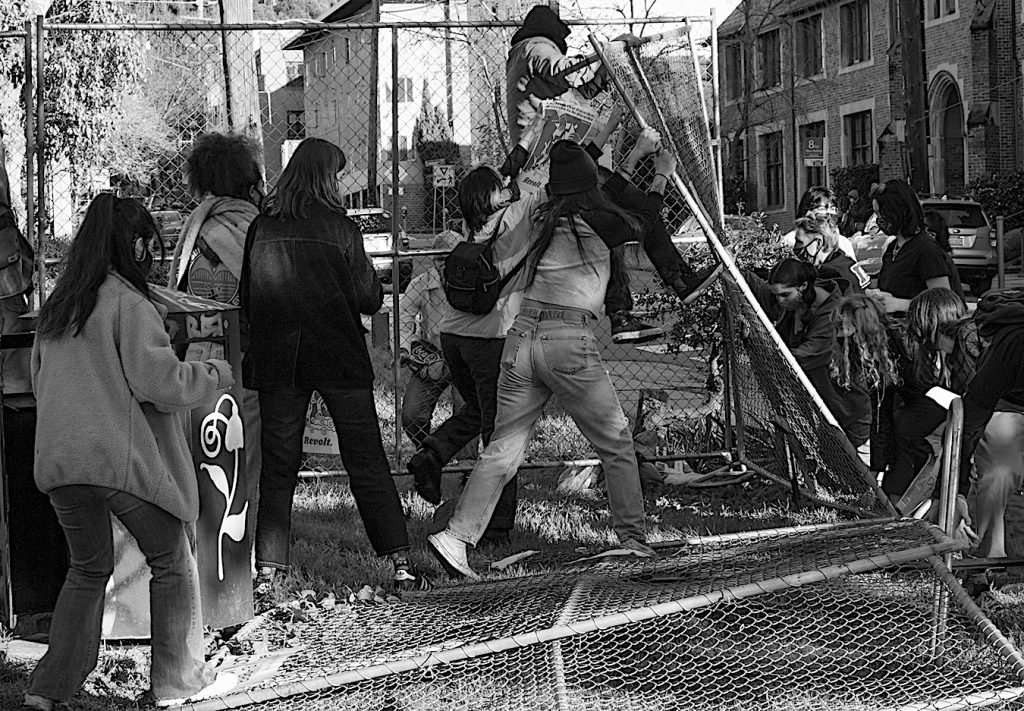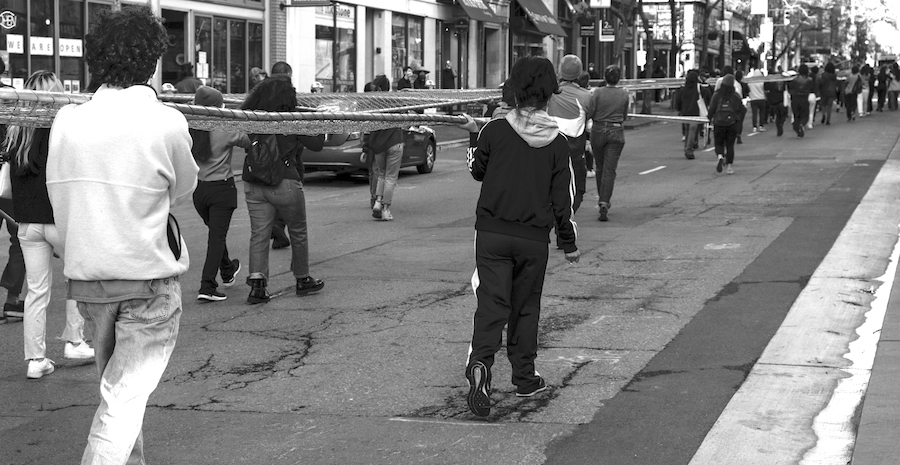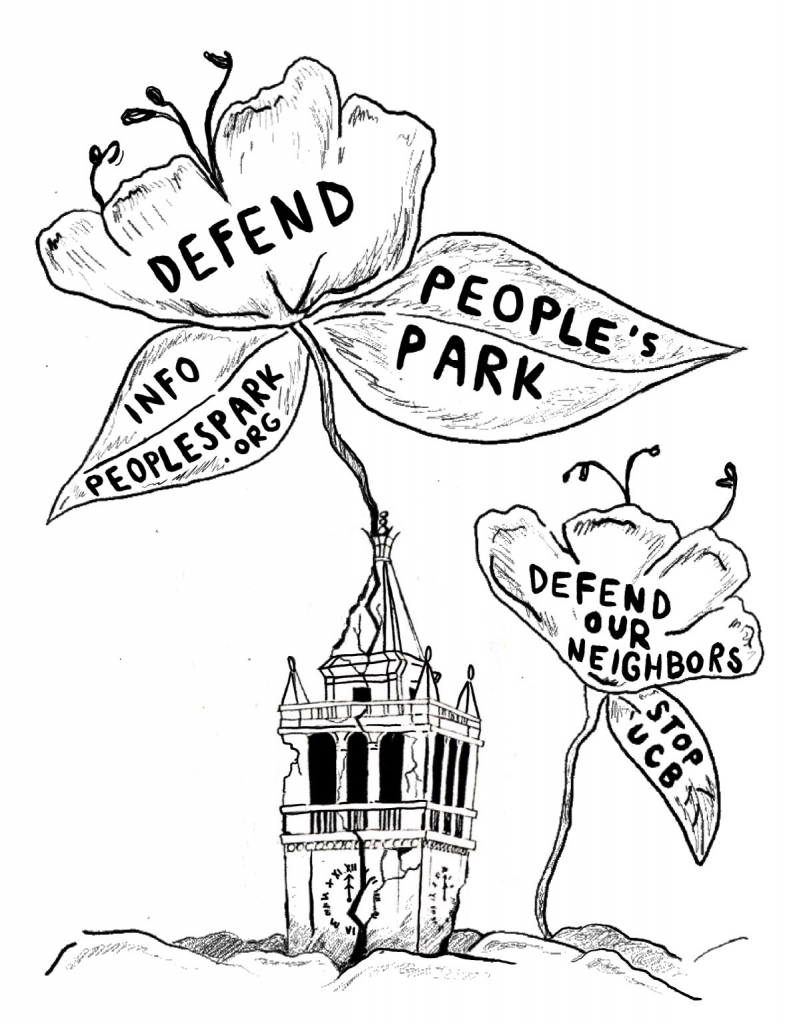
By J. Montigue & Stooge
There is something magic about People’s Park in Berkeley — like a scrappy cat with 999 lives. Just when the University of California was finalizing plans to build a 16-story, 1,200 unit dorm on the park amidst the tidal wave of gentrification sweeping the Bay Area, UC Berkeley students swept in to join community members and say “not so fast.” As Slingshot goes to press, students have set up an occupation camp to prevent UC from drilling their last batch of soil samples related to the dorm. Events are happening in the park every Friday, there are frequent marches and protests, the student government and other student groups have issued statements in favor of preserving the park — once again the University finds itself knocked on its heels and mystified about the Park’s endless energy to inspire each new generation. A new mood is in the air — UC’s development plans are not inevitable.
People’s Park was constructed without permission in 1969 to create a beautiful community on vacant UC land. Protests about the Vietnam war and civil rights were against the system — the park represented a new chapter of resistance in which people began to build a new world worth living in. UC’s first attempt to seize back and destroy the park led to rioting, police shootings that left bystander James Rector dead and dozens wounded, and a week-long National Guard occupation of Berkeley. UC has always claimed to own the land on Dwight Way east of Telegraph, but since 1969 they have never been able to control it. Over the years, park users have practiced “user development” by building and tending gardens, trees and landscaping as determined by users, not government managers. It is a rare place in the city open to everyone, hosting a free speech stage and daily free food servings.
The issues connected to the Park are vital — people seek freedom to use and enjoy land, not just hold it for profit and greed. We demand direct involvement in creating the world and deciding how things should work in our community because these processes bring meaning to our lives. UC’s bureaucratic and dehumanizing management treats people and neighborhoods like computer circuits waiting to be programmed.
An unspoken justification for UC’s dorm is to displace homeless people who hang out at the Park — but it is a paradox, because these days there are homeless encampments on every corner so no one can seriously believe that destroying the Park could “fix” homelessness. UC has done everything it could to push homeless people to the Park, bias its students against the homeless by conflating poverty with crime, and try to make the park a festering eyesore by tearing out trees, the children’s playground, freeboxes, gardens and other improvements constructed by Park users. It made its own bathroom inhospitable and prison-like with no soap or hot water (even during the pandemic). In 2018 on the verge of the 50th anniversary, UC cut down 42 trees without warning or consideration. After decades of UC policy to undermine the Park, they now want to take credit for “cleaning up.” But the real mess is capitalism and a system that builds palaces for the few and leaves so many people out in the cold. UC claims the land is theirs and treats the park users and residents the way they treat the trees — disposable, worthless, unprofitable.
In this context, at the worst point in the pandemic, UC closed off most of the park with double-high metal fences and set up whirring generator-powered surveillance systems to protect drilling rigs. Park defenders had a rally on January 29 and 150 gathered — many of them in the Park for the first time. Everyone stood or sat on the ground, eye-to-eye at the same level and many spoke passionately. As the afternoon wore on, the sun cast long shadows on the golden grass — a crosshatch pattern of the fences that loomed above. An air of readiness and excitement grew and then like an unstoppable magnetic force, the crowd ran and tore the fence down and carried the pieces a few blocks to the University where it was piled in front of the administration building.
So started the student occupation — tents, hammocks — bringing foods and masks and gloves. Street medics from around the Bay area came to offer medical and mental health assistance to student defenders and unhoused park residents alike. Tense and dangerous situations have been de-escalated, or at least survived, with the collaboration of park elders, residents, and students instead of police. Occupiers put care and attention into the park — picking up trash and bringing friendliness and conversation so the park felt alive and fresh and not ignored or so scary.
As the occupation goes on, the focus has shifted from “occupation” (which implies a colonial presence) to “defense” and healing. New focuses are mutual aid, growth through gardening, and care of the land. There are regular arts events, classes, and movie nights. All are closely connected to realizing the park’s promises of autonomy and self-determination and defending it from the UC war machine through direct action. As the capitalist housing crisis has worsened, pushing the poor and people of color further to the margins of Berkeley, the park has become an essential refuge and cultural center.
It’s time to organize and share the knowledge between the generations, the resources between the housed students and the unhoused, to plan the defense of the park from UC’s colonial entitlement, and grow something together in a different way. The People’s Park committee is reaching out to see how the land could be re-matriated to indigenous stewardship, ending the landlordship of the UC once and for all. Contrary to what UC likes to say, the park is an essential and vibrant place today, not just history to get memorialized in a plaque.
To get involved, if you are in the Bay Area, come by People’s Park on Fridays at 3PM for the weekly community assembly, food, and events. Visit @peoplesparkberkeley on Instagram or venmo @pparkberk if you are able. For more info, visit peoplespark.org.
People’s Park forever! Let a thousand parks bloom!


